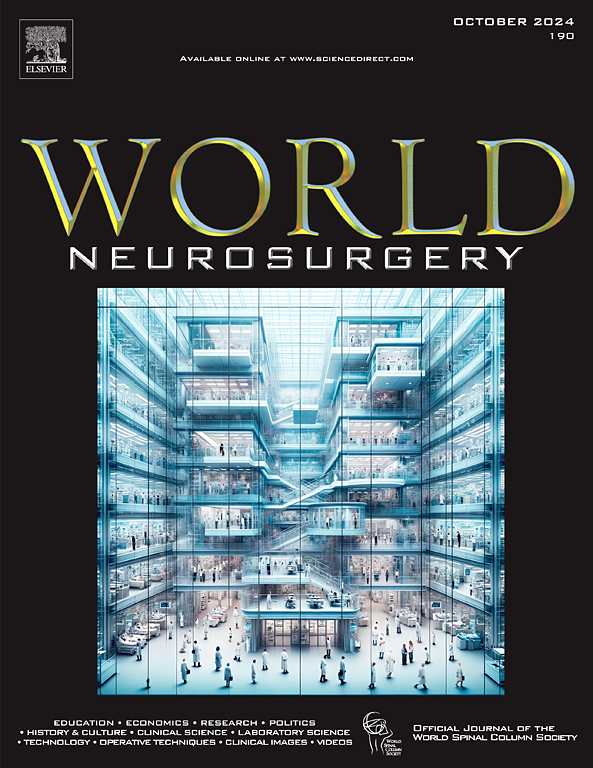显示四脊髓中脑海绵畸形的构造板下丘交叉脑干综合征。
IF 1.9
4区 医学
Q3 CLINICAL NEUROLOGY
引用次数: 0
摘要
海绵畸形是一种低流量的脆性血管病变,容易发生腔外出血,可发生在大脑半球、脑干或脊髓。我们报告了一例 32 岁右撇子男性患者的病例,该患者急性发作头痛,伴有右侧耳鸣、右侧偏盲和双眼复视,与颅神经 IV 麻痹有关。神经影像学检查显示,患者左侧孤立的下构造板海绵畸形,并有颅外出血的证据。临床表现和神经影像学特征均符合下丘脑交叉脑干综合征。由于临床症状有所改善,神经影像学检查也未发现肿块效应,手术治疗被推迟。三个月后复诊时,除了复视需要佩戴棱镜外,其他症状均已改善。构造海绵畸形占中脑海绵瘤的 18%。医生解释说,如果再次发生小脑外出血并导致致残症状,将在 2 个月内采用小脑上皮下入路进行手术切除。本文章由计算机程序翻译,如有差异,请以英文原文为准。
Crossed Brainstem Syndrome of the Tectal Plate's Inferior Colliculus Revealing Quadrigeminal Midbrain Cavernous Malformation
Cavernous malformations are low-flow fragile vascular lesions prone to extralesional bleeding that can occur in the cerebral hemispheres, the brainstem, or the spinal cord. This paper reports the case of a 32-year-old right-handed man with acute-onset headaches associated with right-sided tinnitus, right-sided hemianesthesia, and binocular diplopia related to cranial nerve IV palsy. Neuroimaging displayed left-sided isolated cavernous malformation of the inferior tectal plate, with evidence of extralesional bleeding. Clinical presentation and neuroimaging features were compatible with inferior colliculus crossed brainstem syndrome. Thanks to clinical improvement and the absence of mass effect on neuroimaging, surgical intervention was delayed. At the 3-month follow-up consultation, symptoms had improved aside from diplopia, which required wearing prism eyeglasses. Tectal cavernous malformations account for 18% of midbrain cavernomas. It was explained that surgical excision using the supracerebellar infratentorial approach would be performed within 2 months after a second extralesional bleeding episode causing disabling symptoms.
求助全文
通过发布文献求助,成功后即可免费获取论文全文。
去求助
来源期刊

World neurosurgery
CLINICAL NEUROLOGY-SURGERY
CiteScore
3.90
自引率
15.00%
发文量
1765
审稿时长
47 days
期刊介绍:
World Neurosurgery has an open access mirror journal World Neurosurgery: X, sharing the same aims and scope, editorial team, submission system and rigorous peer review.
The journal''s mission is to:
-To provide a first-class international forum and a 2-way conduit for dialogue that is relevant to neurosurgeons and providers who care for neurosurgery patients. The categories of the exchanged information include clinical and basic science, as well as global information that provide social, political, educational, economic, cultural or societal insights and knowledge that are of significance and relevance to worldwide neurosurgery patient care.
-To act as a primary intellectual catalyst for the stimulation of creativity, the creation of new knowledge, and the enhancement of quality neurosurgical care worldwide.
-To provide a forum for communication that enriches the lives of all neurosurgeons and their colleagues; and, in so doing, enriches the lives of their patients.
Topics to be addressed in World Neurosurgery include: EDUCATION, ECONOMICS, RESEARCH, POLITICS, HISTORY, CULTURE, CLINICAL SCIENCE, LABORATORY SCIENCE, TECHNOLOGY, OPERATIVE TECHNIQUES, CLINICAL IMAGES, VIDEOS
 求助内容:
求助内容: 应助结果提醒方式:
应助结果提醒方式:


